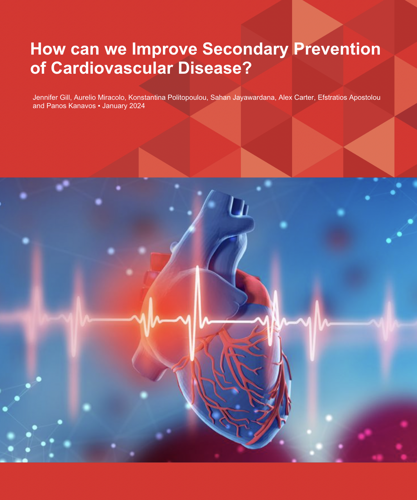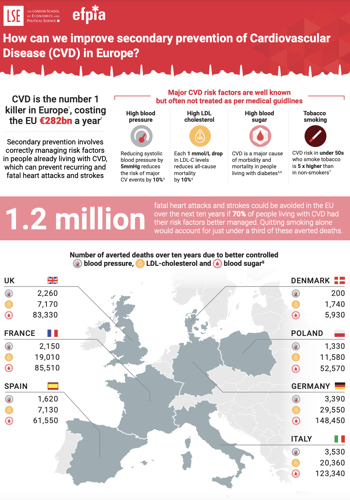Cardiovascular disease: LSE-report highlights life-saving potential of secondary prevention
More than 1 million fatal heart attacks & strokes could be prevented with better management of four risk factors
Cardiovascular disease (CVD) is the number one killer in Europe, but a new study by the London School of Economics and Political Science (LSE) shows the opportunity to save hundreds of thousands lives. The report, commissioned by the European Federation of Pharmaceutical Industries and Associations (EFPIA), features six recommendations that can reduce the risk of fatal heart attacks and strokes in people living with CVD, by following medical guidelines.
CVD costs the EU €282 billion a year, and 65% of avoidable CVD deaths occur in the working age population[1] [2]. While overall mortality rates have improved over the last two decades, progress has plateaued. Many patients who have suffered from a CVD event are highly vulnerable and likely to experience an often fatal repeat heart attack or stroke. Therefore, the report looked at the potential to save the lives of these patients through better control of the most prevalent risk factors.
Appropriate management of high cholesterol, high blood pressure, high blood glucose and smoking, while encouraging healthier diets and physical activity, can reduce the risk of death from repeat heart attacks and strokes. In fact, the report proposes that more than 1 million fatal CVD events could be avoided in the EU over the next 10 years if 70% of people living with CVD had their risk factors better managed than they are today.
“There is a huge opportunity to address reversible risk factors in people who are already living with CVD,” said Nathalie Moll, Director-General of EFPIA. “If existing evidence-based treatment targets and recommendations are followed, the impact will be profound.”
Recommendations to improve secondary CVD prevention:
- Joint Diabetes & Heart Health Checks: For at-risk individuals, available in accessible settings, standardised to ensure early diagnosis of CVD and effective intervention across the EU.
- EU Cardiovascular Plan: Following the European Alliance for Cardiovascular Health (EACH) proposal[3], including better implementation of scientific guidelines and robust funding.
- National Cardiovascular Health Plans: To ensure access to CVD-related healthcare, reducing inequalities in CVD prevention and treatment across the EU.
- Standardised Treatment Guidelines: Ensure all EU Members States follow standardised guidelines so that patients are enabled to reach their targets for blood pressure, cholesterol and glucose.
- Better Data Collection: Enhance data collection across the EU to allow for more accurate estimates of the power of optimised secondary prevention and calculation of cost-benefits.
- Healthcare System Incentives: Design incentives (e.g. key performance indicators and pay-per-performance schemes) to increase the proportion of patients reaching targets.
Background
Commissioned and funded by EFPIA, this report was produced by LSE experts using data from seven European countries: Denmark, France, Germany, Italy, Poland, Spain and the United Kingdom. It found that enhancing secondary prevention in these countries could prevent 67,170 fatal cardiovascular (CV) events (heart attack and stroke) per year. This equates to 671,700 avoided fatal CV events over the next ten years via improved management of hypertension, hyperlipidaemia and diabetes.
Encouraging 70% of patients with CVD who smoke to quit could prevent an additional 27,189 fatal CV events per year (271,890 over the next ten years). Considering roughly 1.8 million deaths in 2019 in these seven countries have been attributed to atherosclerotic cardiovascular disease (ASCVD), the prevention of almost 95,000 (94,359) fatal CV events represents a 5% improvement per year. Across ten years this could mean the prevention of nearly a million deaths (943,590) in the seven countries analysed in the report. Further gains would be achieved by the widespread adoption of the recommendations identified through this project.
Europe’s health systems are under immense pressure. Of the €282 billion spent on CVD in 2021, €130 was on hospitalisation and another €47 billion on lost productivity from premature deaths. This LSE report offers straightforward recommendations to mitigate CVD severity to reduce the need for hospitalisations, while also preventing thousands of deaths every year.
Download the report
[1] Luengo-Fernandez R. et al. Economic burden of cardiovascular diseases in the European Union: a population-based cost study. Eur Heart J 2023
[2] Trends in Avoidable Mortality from Cardiovascular Disease in the European Union. LSE Consulting. April 2023
[3] EACH: A European Cardiovascular Health Plan. The need and the ambition (2002) EACH-Plan-Final_130522.pdf (cardiovascular-alliance.eu)

